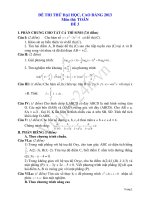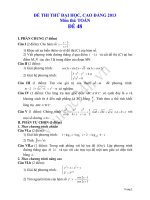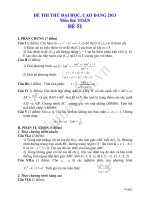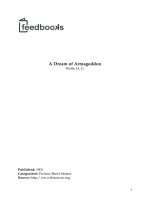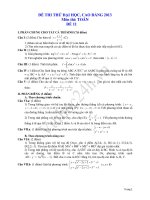Good Indian By B.m. Bower potx
Bạn đang xem bản rút gọn của tài liệu. Xem và tải ngay bản đầy đủ của tài liệu tại đây (780.48 KB, 38 trang )
© 2011, David Bowman
All rights reserved. No part of this document may be copied, sold, or distributed,
in either printed or electronic format, without the written permission of David Bowman.
For more information, contact ,
Smashwords Edition, License Notes
This e-book is licensed for your personal enjoyment only. This e-book may not be re-sold or
given away to other people. If you would like to share this book with another person, please
purchase an additional copy for each person. If you’re reading this book and did not purchase it,
or it was not purchased for your use only, then please return to Smashwords.com and purchase
your own copy. Thank you for respecting the hard work of this author.
What People Say about Precise Edit’s Writing Guides
…A choice pick!
(Midwest Book Review)
I compliment you on an excellent compilation of expert advice.
(Pam H., Sunshine Valley Writers Group)
David Bowman’s advice on grammar, style, and English usage is both sound and effective
because it reflects current scholarly research and best workplace practices.
(Scott Sanders, Associate Chair for Core Writing, Director of Professional Writing and
Internships, University of New Mexico)
I love the concise, no nonsense format of the guides. They are easy to read and reference, and
they make me a better writer. Written concisely in plain English with examples for each topic . . .
an incredible and inexpensive tool writers of all abilities should possess.
(Gary Hawk)
Precise Edit’s tips offer serious value to anyone who wants the edge that polished
communications can bring. This pithy, clever, slightly irreverent series should help writers of all
skill levels avoid mistakes, communicate with confidence, and stand out from the crowd.
(Will Reichard, CrossCut Communications Public Relations & Marketing)
The Precise Edit Training Manual is an excellent reference for any writer keen not only to
communicate clearly but also to ensure correct use of grammar and punctuation.
(Pauline)
Bang! has been a good read.
(D. Dericotte)
I've been looking for a good book/document that deals with common writing problems and I'm
glad to say I've found it in your training manual.
(Aaron Ng)
Good advice that many writers should read!
(W.W.)
Bowman explains complex ideas . . . in interesting and approachable ways.
(John UpChurch, Amazon reviewer)
About the author
David Bowman is the owner and chief editor of Precise Edit, a comprehensive editorial service
provider with specialized services for authors, students, business professionals, and other
individuals who need to communicate well in writing. Core services include content editing,
copyediting, and documental editing.
Mr. Bowman is an editor with over 20 years of experience. He has advanced degrees in both
comparative literature and business administration. He is a popular writing instructor for the
University of New Mexico and a communications consultant to small and medium-sized
organizations. He uses the writing strategies in these books to help clients reach their goals.
You can read more information about Precise Edit and the author at .
Precise Edit can help you:
• publish books that others will buy, read, and enjoy;
• communicate clearly and effectively with stakeholders and business partners;
• submit better academic papers;
• inform and persuade your readers.
For more information
Visit , e-mail , or call 888-474-4393.
Information and purchasing
For more information about the writing guides and to purchase them, visit
Hostile Editing: .
Your Writing Companion
Writing Tips for a Year
300 Days of Better Writing
Zen Comma
Precise Edit Training Manual
Bang! Writing with Impact
Which Word Do I Use? A Quickie Guide to the Most Confusing Word Pairs
Table of Contents
Bowman’s Concise Guide to Technical & Academic Writing
Introduction
From Chapter 3: Style
From Chapter 6: Sentence Structure
300 Days of Better Writing
Introduction
Day 1: Use the rhetorical subject as the grammatical subject.
Day 2: Place a comma before a conjunction that joins two independent clauses.
Day 3: Be concise.
Day 4: Avoid over-generalizing.
Day 5: Finish sentences with the most important information.
Day 6: Place ending punctuation inside the quotation marks.
Day 7: Use you only when you are writing to or about the reader.
Day 8: Limit adjective use.
Zen Comma
Introduction
Sample Chapter Structure
Comma Topics in Zen Comma
2. Commas When Joining Sentences
Bang! Writing with Impact
Introduction
Sample Strategies for Impact
5. Emphasize alternatives by adding the conjunctions “or” or “nor” between all items in a series.
19. Emphasize a particular characteristic by pairing it with its opposite.
39. Attack the credibility of your critics to emphasize the superiority of your ideas.
58. Increase reader engagement by omitting the conclusion to a logical argument.
96. Provide a summary of previous content to emphasize how it relates to the next topic.
Precise Edit Training Manual
Introduction
It Is What It Is (Starting sentences with it)
Which Word Do I Use?
That vs. Which
Good vs. Well
Information about these 5 Guides
INTRODUCTION
The Society of Technical Writers describes technical writers as people who “research and create
information about technical processes or products directed to a targeted audience through various
forms of media.” This description touches on two foundations of technical writing: information
and targeted audience. With this in mind, technical writing is far more than creating user
manuals.
Technical writing is an approach to presenting information to a defined reader in an objective,
direct, easy-to-understand manner. Technical writing is a strategy for providing what the reader
needs in a manner that the reader can most easily use it. In other words, technical writing is good
writing.
Technical writing follows several principles.
• The reader is more important than the writer.
• The style must be consistent with the purpose.
• Clear, simple writing increases understanding.
• Logical organization shows how ideas connect.
• The reader needs to know how to find information.
• Information sources must be given credit.
• Correct grammar, punctuation, and word choice enhance credibility.
The purpose of this book is to help you implement these principles and write well.
From Chapter 3: Style
B. Language Complexity
Some writers use simple, straightforward sentences with few modifying phrases and clauses.
Others use complex sentences with many modifiers, interjected descriptions, and multiple
clauses and phrases.
Example B.1, simple sentence: “Lisa bought a red car.”
This simple sentence contains a simple subject (Lisa) and a simple predicate with an object
(bought a red car). This sentence has two modifying words (a, red) but no other phrases or
clauses.
Example B.2, moderately complex sentence: “When the day ended, Lisa, a sales clerk at the
downtown market, bought a red car.”
This moderately complex sentence has an introductory descriptive clause (when the day ended),
a simple subject (Lisa), an appositive for the subject (a sales clerk at the downtown market), and
a simple predicate with an object (bought a red car).
Example B.3, very complex sentence: “When the day ended, which couldn’t have happened
soon enough, given the type of day she had had, Lisa, a sales clerk at the downtown market, a
grimy, dark nook in an old building, bought what she mistakenly thought was a new, or, at the
worst, slightly used, red car.”
This very complex sentence has an introductory descriptive clause (when the day ended), a
description of the introductory clause (which couldn’t have happened soon enough), a
description of the description of the introductory clause (given the type of day she had had), a
subject (Lisa), an appositive for the subject (a sales clerk at the downtown market), a description
of the appositive for the subject (a grimy, dark nook), and a description of the description of the
appositive for the subject (in an old building). And then we finally get to the predicate, which is
similarly complicated.
As these three examples show, the two key features of language complexity are
1. the number of descriptive phases and clauses and
2. the levels of description (such as description of description).
A careful writer considers sentence complexity in light of the readers’ needs. Simple sentences
can be read quickly and understood easily. As sentences become more complex, they contain
more information and “flavor,” but they require more work from the readers and increase the
potential for misunderstanding.
As with all style issues, the level of language complexity needs to fit the readers’ needs. Simple
sentences are the most easy to understand. They present minimal information in a
straightforward manner, with no interruptions in the main thought being communicated. On the
other hand, using too many simple sentences, or a string of simple sentences, makes the writing
appear amateurish.
For technical manuals, lists of instructions, user guides, and other documents that present single
action steps, stick with simple sentences. For most other types of documents, the writer can
present more complex information and create better reader interest and engagement by using a
mix of simple and moderately complex sentences. If your goal is reader understanding and
interest, avoid very complex sentences. Overall, you will communicate best by
• using a mix of simple and moderately complex sentences,
• limiting the number of descriptive phrases,
• presenting only one descriptive phrase at a time, and
• avoiding descriptions of descriptions.
Sentence structure will be addressed in greater detail in Chapter 6, Sentence Structure.
C. Objectivity
Feelings, emotions, opinions, and beliefs are called, collectively, individual perspective. An
individual perspective indicates the perspective of one person: the writer. In all forms of
technical writing, your individual perspective is inappropriate.
Think about your reader. Your reader is seeking believable, credible information. Your opinions,
etc. are not believable, credible information. They only apply to you; they do not apply to your
reader.
The most obvious cases are sentence that contain such phrases as I feel that, I believe, and in my
opinion. If you can express the idea as a fact, do so. If you cannot express the idea without those
phrases, remove the sentence entirely.
Writers also interject their individual perspectives by using particular words and by making
judgments, as explained below.
1. Word choice: Writers damage the objectivity of their writing (and its value) by using
adjectives and adverbs that indicate an individual perspective. For example, these two sentences
contain opinions:
Example C.1: “The marketing plan indicates exciting opportunities for the company.”
Example C.2: “The friendly sales associates will greet our valued customers by name.”
In these samples, the words indicating the individual perspective are exciting, friendly, and
valued.
Some words indicate individual perspectives with greater subtlety through their connotative
meanings. The connotation of a word implies more than the objective meaning of the word. This
not only increases the likelihood for misunderstanding but also reflects the writer’s opinion. For
example:
Example C.3: “Rescue crews sorted through the carnage from the plane crash.”
Here, carnage implies the writer’s impression of the scene. It evokes visions of war, of disaster,
and of tragedy. A more objective word is wreckage.
2. Moral Judgments and Persuasion: A writer expresses an individual perspective by using
such words as should, must, and ought to. (The technical term for this type of word is modal
auxiliary.) In most cases, writers use these words to persuade the reader to act or think in a
specific manner. This is a problem for several reasons.
First, these words will always create conflict with the reader. They communicate your belief that
you have the right to tell the reader what to do. The reader is unlikely to share that belief.
Second, they state an opinion as a moral judgment. Moral or otherwise, an opinion is still just
that: an opinion. The reader will recognize that you are providing your opinion and can,
therefore, reject your ideas. Third, they disrespect the reader. They communicate that you don’t
trust the reader to decide what to do.
As a persuasion technique, this rarely works. In technical writing, it is inappropriate. A better
approach is to state ideas as facts and to connect the facts to a desired outcome. A reader can
argue against, or simply reject, your opinions easily. However, the reader cannot argue against
objective facts. In the following examples, example C.4a communicates an opinion, and example
C.4b communicates a fact.
Example C.4a: “The WHO should provide funding for sanitation projects in third-world
countries. This will reduce the incidence of diarrhea in third world countries.”
Example C.4b: “The WHO will reduce the incidence of diarrhea in third world countries by
providing funding for sanitation projects.”
Example C.4a makes a moral judgment. In the writer’s opinion, the WHO will do the “morally
right” thing by providing funding. Example C.4b provides a fact. The reduction in incidences of
diarrhea will occur if the WHO provides funding. Moral judgments create conflict. Facts
persuade.
3. Personal Pronouns: Writing in an objective style does not mean avoiding I and we. These
personal pronouns are acceptable if you are describing your actions or processes. You can write
“We did this” or “I did that.” This approach is preferable to writing such artificial phrases as “the
author of this report found ” The reader knows that you are the author. Use I.
When you write I or we, examine your sentence critically and ask what you are communicating.
If you are communicating a fact, the personal pronoun is acceptable. If you are communicating
an opinion, it is not.
4. Describing Opinions: At times, you may need to provide opinions, feelings, and beliefs. It is
possible to do so in an objective manner. Although you don’t want to offer your own individual
perspective, you can describe the individual perspective of others. For example, rather than
stating
“I believe the president is doing a good job,”
you can state
“22% of survey respondents believed the president is doing a good job”
or
“The president believed he was doing a good job.”
In this way, you are simply providing the facts about others’ opinions. That other people believe,
feel, etc. this way is a fact. Technical writing is not about you, but it can be about other people.
From Chapter 6: Sentence Structure
A. The Subject-Verb-Object Structure
Every sentence has two basic parts, the subject and verb. Many sentences contain a third basic
part, the object. Together, these three parts contain the main message in a sentence, and they
answer the readers’ question: Who did what to whom? This means that they need to be as
obvious as possible to the reader. Every sentence editing strategy springs from this concept.
Once you have identified the meaningful subject (section 4.A), meaningful action (section 4.B),
and object, you can apply the S-V-O strategies below.
1. Place the verb as close to the subject as possible. The subject and verb are the two most
important words in a sentence. When the verb immediately follows the subject, the reader will
connect the verb to the subject and understand the main point of the sentence. In example A.1a,
the verb is separated from the subject. In example A.1b, the main verb is next to the subject, and
the sentence is easier to understand.
Example A.1a: Any checking account established by persons living outside the United States
and not registered with the banking commission falls under international regulations.
In example A.1a, the subject and main verb are account and falls, respectively. 15 words of
description separate the subject and verb, including three more verbs. This sentence has two
potential problems. First, the separating words interrupt the main point of the sentence, which
reduces the emphasis on the main point. Second, with three other verbs before the main verb, the
reader may associate the wrong verb with the subject, causing the reader to misunderstand the
main point entirely.
Examples A.1b and A.1c fix this problem by placing the main verb immediately after the subject.
Example A.1b: Any checking account falls under international regulations if it is established by
persons living outside the United States and not registered with the banking commission.
Example A.1c: If a checking account is established by persons living outside the United States
and is not registered with the banking commission, it falls under international regulations.
2. Place the main subject and verb at the beginning of the main sentence: Once the subject
and main verb are together, move them to the beginning of the main sentence. This strategy is
called “front loading” because it “loads” the beginning of the sentence with the most important
information. By using this strategy, you immediately answer “Who did what to whom?” as seen
in example A.2.
Example A.2: Submarine eruptions create new islands through the gradual, though sometimes
drastic, buildup of lava flows and other eruptive matter.
Even if the reader becomes confused with all the description, the reader will understand the main
message. This strategy does not require every sentence to begin with the subject and verb, which
would produce the “washboard effect” (section 6.B). Rather, it applies to the beginning of the
main sentence.
Example A.3: By using quantitative research methodologies, researchers attempt to identify
common themes and patterns exhibited by the study population.
In example A.3, the sentence begins with a descriptive phrase. The main sentence begins with
researchers attempt, which are the subject and verb. Indeed, readers expect to find the subject
immediately after an introductory description. If the subject is not there, the sentence will seem
awkward, and the reader may be confused.
3. Limit the number of subject–verb pairs: Every complete sentence has a main subject–verb
pair. A simple sentence has subject–verb pair, but a complex sentence may have several. Each
additional subject–verb pair increases the level of complexity and increases the potential for
confusion. Example A.4 has five subject–verb pairs.
Example A.4a: When engineers envision the required component they will use to perform a
function, they consider how the component fits within a comprehensive system within which
components interact and both enable and limit other components.
As the number of subject–verb pairs increases, the reader becomes more likely to identify the
wrong pair as the main subject and verb. Limit the main sentence to no more than two pairs and
any introduction to no more than one pair. Example A.4b follows this guideline.
Example A.4b: When engineers envision the component needed to perform a function, they
consider how the component will fit within a comprehensive system. They determine how the
various components will interact and enable and limit other components.
This does not apply to subject–verb pairs within a series. The parallel structure of a series
prevents reader confusion.
Example A.4c: When engineers envision the required component, they consider what function
the component will perform, how the component fits within a comprehensive systems, and how
the components interact.
4. Keep subject–verb pairs separate: As noted previously, a sentence may have more than one
subject-verb pair. To improve the potential for reader understanding, keep the subject–verb pairs
separate, i.e., write only one at a time.
Example A.5a has three subject–verb pairs but does not follow this strategy.
Example A.5a: The business owners we serve through a comprehensive set of tools our experts
created attain greater financial stability.
In this sample, I underlined the main subject–verb pair and put the other two pairs in italics. The
main subject in Example A.5a is business owners. However, before reaching the main verb,
attain, the sentence has two more subject–verb pairs, we serve and experts created. Restructuring
this sentence graphically helps demonstrate how two subject–verb pairs are embedded in the
main pair.
The business owners
we serve
experts created
attain greater financial stability
Figure 1. Embedded subject–verb pairs
To follow the one-at-a-time strategy, we can restructure the sentence as follows.
Example A.5b: Using a comprehensive set of tools our experts created, we help business
owners attain greater financial stability.
Again, the main subject–verb pair is underlined and the other two pairs are italicized. Each pair
ends before another begins. In this revision, the main subject–verb pair changes from business
owners attain to we help, which makes us (or we) responsible for the result: business owners
attain greater financial stability. If we want to keep the focus on the business owners (i.e., the
meaningful subject), we use business owners as the grammatical subject. One possible revision is
as follows.
Example A.5c: Business owners attain greater financial stability by using the comprehensive set
of tools our experts created.
5. Summary of S-V-O strategies: This section has provided a lot of information. In summary,
these are the key strategies for using the basic Subject-Verb-Object sentence strategy.
1. Use the S-V-O sentence structure: meaningful subject + meaningful action + object.
2. Place the verb as close to the subject as possible.
3. Place the main subject and verb at the beginning of the main sentence.
4. Limit the number of subject–verb pairs.
5. Keep subject–verb pairs separate.
When you follow these five strategies, you will solve most problems with sentence structure and
reader understanding.
Back to top
INTRODUCTION
Welcome to 300 Days of Better Writing. This writing guide provides you with 300 strategies for
writing clearly, effectively, and correctly. This is a great companion to our Precise Edit Training
Manual, although each book can be used independently. Whether you read one new tip a day,
read them all at once, or find a specific topic you need, this guide will help you write better.
How this guide is organized
This guide loosely follows the organization of the tips in our Writing Tips for a Year series. We
distributed the editing, writing, and mechanics tips so you won’t receive tips of the same type all
at once. Broad writing topics (e.g., paragraph structure) are broken into individual strategies.
These are also distributed throughout the tips so that you have time to learn, practice, and master
one strategy before learning a new strategy on the same broad topic.
Day 1: Use the rhetorical subject as the grammatical subject.
Every complete sentence needs a subject. The subject is the Thing, Idea, Person, or Place (TIPP)
that “does” the main verb. Consider the sentence “Tom loves Julie.” The main verb here is
“loves,” and the subject is “Tom.”
Another name for the subject of a sentence is “grammatical subject.” In the previous example,
“Tom” is the grammatical subject because “Tom” is the subject of the sentence.
Sometimes, though, the “doer” of the main action is not the grammatical subject. Consider this
sentence: “Finding a solution is our greatest concern.” In this example, “Finding a solution” is
the grammatical subject of the verb “is.”
However, we need to ask, “What’s the action being described by this sentence?” The main action
is finding a solution. Then we ask, “Who is doing this action?” The answer is “We are.” “We,”
therefore, is the rhetorical subject. The TIPP that does the main action is the rhetorical subject,
whether or not it is the grammatical subject.
For clear and effective writing, the rhetorical subject should be used as the grammatical subject.
Based on this, the example sentence can be revised as follows: “We are most concerned with
finding a solution.”
Day 2: Place a comma before a conjunction that joins two independent
clauses.
The term “independent clause” refers to a complete sentence, whether it stands alone or is part of
a longer sentence. It has a grammatical subject and a main verb, at a minimum.
Consider the sentence, “Tom loves Julie, and Julie loves Frank.” This has two independent
clauses. The first is “Tom loves Julie,” and the second is “Julie loves Frank.” The two clauses are
joined by “and,” so you need a comma before the “and.”
Whenever you join two independent clauses by a conjunction (and, but, or, yet, so, for, nor), put
a comma in front of the conjunction.
Consider the sentence “Mary winked at me, and Bob sighed.” If you leave out the comma before
“and,” the reader will have to decide whether Mary winked at only me or if she winked at me
and Bob. Only when the reader gets to “sighed” will he or she realize that Mary is winking at me
and that Bob is the person sighing. This makes the sentence confusing, and the reader may have
to re-read it to understand its meaning.
That comma makes the sentence clear.
Day 3: Be concise.
“Good things, when short, are twice as good.” (Baltasar Gracian)
Although this quote could be applied to many things, Gracian refers specifically to writing. His
point, and it’s a good one, is that texts written simply and briefly are superior to texts written in a
lengthy and grandiose style. Longer does not mean better. In fact, the opposite is generally true.
A writer who intentionally lengthens his or her documents will not produce good writing, and the
reader will most likely be turned off. However, this does not mean that short is better, either. The
point is for everything you write to add value to the reader.
When we talk about economical writing, we echo Gracian. Say what you have to say, but say it
simply, clearly, and briefly. Then stop.
Day 4: Avoid over-generalizing.
One of my favorite expressions as a kid was, “Oh, yeah? Prove it.” (I was a precocious child.)
Over-generalizing means making a general statement or reaching a conclusion from a very
limited number of examples. When you over-generalize, you invite your reader to ask, “Oh,
yeah? Prove it.”
If you base an argument, concept, fact, idea, etc. on your over-generalized statement, the reader
can discredit everything you have written. The reader only needs one example to prove you
wrong.
Here’s the tip that accompanies “avoid over-generalization”: When you make a general
statement, make sure it’s true in EVERY case.
Some examples of over-generalizing are:
• “As everyone knows . . .”
• “She was always smiling.”
• “People loved her cooking.”
• “This is the most exciting movie.”
• “The stores in this town are no good.”
• “Text books are boring.”
• “People do this when they’re tired.”
• “Men are pigs, but women are angels.”
• “It figures.”
Day 5: Finish sentences with the most important information.
Why finish sentences with the most important information?
• Information at the end of a sentence has the most emphasis, the most impact.
• People tend to remember best what they last hear or read.
• Information at the end of a sentence serves as a transition to the next sentence. When you
provide important information, you will likely write more about it or address it in some
way.
Ask yourself, “What point am I trying to make, or what important idea am I trying to
communicate, in this sentence?” Revise your sentence to place that information at the end.
Day 6: Place ending punctuation inside the quotation marks.
[Note to our friends in Great Britain: reverse the tip in the next paragraph, and you will probably
do fine.]
When providing a direct quote or using quotation marks to indicate that you are writing about a
word or phrase, the comma or period that ends the phrase or sentence should be placed inside the
final quotation mark. [GB: outside the final quotation mark]
Examples:
• John said, “I am in love with Julie.”
• Many people don’t pronounce the final sound of the words “fast,” “quit,” and “stop.”
• When the man shouted “Halt,” I ran away.
However, if your final punctuation is a question mark, semi-colon, or colon, and if that
punctuation mark is not part of the quote, then it should go outside.
Example:
Did the boss say “fire everyone you can”?
Day 7: Use you only when you are writing to or about the reader.
Writers often use you to express a general observation, but it results in incorrect information.
Recently, I edited a graduate-level paper that repeatedly used you inappropriately. For example,
one sentence said, “When you are in a meeting with your boss, you need to respect his right to
express his opinions.” My response was “But I am the boss!”
This statement did not apply to me, so the information in the sentence was incorrect. The
principle being expressed might be true, but the delivery was wrong.
Here’s another example: “I like this store because they always give you a discount.” My
response was “They never gave one to me!”
Unless you are specifically writing to or about your reader, don’t use you.
Here’s how I revised those two sentences:
“The boss has a right to express his opinions in meetings.”
“I like this store because they always give me a discount.”
Day 8: Limit adjective use.
Adjectives can be useful (such as the one I just used: “useful”), but when you string them
together, they can bore, confuse, and turn off your readers.
Consider this sentence: “The big, green, hairy, smelly monster crept out from under the small,
afraid, whimpering boy’s bed.”
This has three problems. First, it is boring. The point is that a monster crept. All those extra
words detract from the significance of this event. Second, it is complicated. Every time the
reader finds a new adjective, he or she has to modify his or her mental image of what is
happening. Third, it is confusing. Is the bed or the child small, afraid, and whimpering?
Here’s our advice, in three parts:
• Find one word that means what you are trying to say, preferably an action verb or
concrete noun instead of an adjective.
• If you want to use an adjective before a noun, use only one adjective that means exactly
what you are trying to say.
• If you want to use adjectives after the noun, don’t use more than two.
TOPICS DISCUSSED IN 300 DAYS OF BETTER WRITING
300 Days to Better Writing covers 38 topics, listed below with the number of daily strategies that
address each topic. Note: The number of daily strategies below total more than 300. Some
strategies address more than one issue.
agreement, 10
bulleted lists, 7
clarity, 14
commas, 18
conciseness, 27
convincing your reader, 22
dashes and hyphens, 7
descriptions, 33
editing process, 6
engaging readers, 24
formal vs. informal tone, 10
getting to the point, 13
HUPAs, 3
impact and emphasis, 30
introductory phrases / clauses, 11
logic / making sense, 6
mechanics, 20
organization, 14
paragraph structure, 16
paragraphs, 1-sentence, 3
parallelism, 6
preaching, 5
prepositional phrases, 10
pronouns, 9
quotation marks, 4
readers / audience, 23
references / citations, 3
sentence structure, 31
sentence structure, S-V-O, 3
series, 10
spin, 10
subjects, 12
topic chains, 2
transitions, 11
using the correct word (usage), 25
verb usage, 25
writers' advice, 20
writing process, 25
Back to top
INTRODUCTION
Commas confuse most people. Unlike other types of punctuation, they are used in so many ways.
The purpose of this book is to show you how to use them correctly.
As you will see throughout this book, where you put the commas, and where you leave them out,
can change the meaning of a sentence. This means the commas have to be right.
But where does the comma go?
Zen Comma examines the 17 major uses and misuses of commas. This is the book that tells you
where to put commas—and where to take them out. Each chapter provides correct examples,
explains the rules for correct usage, covers common errors, and discusses special
considerations so you can use commas correctly, intelligently, and conscientiously.
The various koans interspersed throughout the chapters are intended to help you “meditate” on
comma concepts. These are short anecdotes about our hero, Bumbo, that illustrate specific
concepts for using commas correctly. Zen Comma also contains exercises to help you identify
comma rules you need to learn.
Sample Chapter Structure
0. Chapter Number and Title, A Basic Use of the Comma
0.1. CORRECT SAMPLE of this type of comma use so you can see how it’s used correctly.
0.2. Another CORRECT SAMPLE of this type of comma use
RULE 0 (NUMBER OF THE RULE)
The comma rule discussed in the immediately following section
Information about how to use the comma correctly: Instructions, considerations, and
explanations of the correct samples above.
0.3. A wrong sample, designated by an asterisk.*
Koan 0
An anecdote about our hero, Bumbo, as he learns to use commas. His experiences help illustrate concepts for using
commas correctly. When you think about these koans and grasp their concepts, you will learn, like Bumbo, to use
commas correctly.
More information about this type of comma use.
Comma Topics in Zen Comma
• Commas in Series
• Commas when Joining Sentences
• Commas after Introductory Descriptions
• Commas with Interjections
• Commas with Appositives
• Commas with Side Comments
• Commas with Names
• Commas with Therefore, Too, and other Conjunctive Adverbs
• Commas with Adjective Pairs
• Commas with Which and Who
• Commas with Final Descriptions
• Commas with Parenthetical Expressions and Absolute Phrases
• Commas with Dates, Addresses, Ages, and Titles
• Commas with Quotations
• No Commas with Either…Or and Other Correlative Pairs
• No Commas between Subjects and Predicates
• No Commas between Compound Predicates
2. Commas when Joining Sentences
2.1. The tomatoes are ripe, but the carrots aren’t.
2.2. The caller was angry, so I want you to talk to her.
2.3. The cost of gas is rising, and fewer people are driving on the highways.
RULE D
Put a comma before a coordinating
conjunction that joins two independent clauses.
Coordinating Conjunctions. The entire list of these conjunctions is For, And, Nor, But, Or, Yet,
So. No other conjunctions fill this role.
Independent Clauses. For all practical purposes, this means a complete sentence. Usually when
we talk about independent clauses, we are talking about an entire section of a sentence that could
be a complete sentence.
The funny thing about this rule is that it’s so easy to demonstrate and follow but so hard to
describe.
Take a look at sample 2.1 above. It has 2 independent clauses: (1) The tomatoes are ripe, and (2)
the carrots aren’t. Sample 2.2 has these independent clauses: (1) The caller was angry, and (2) I
want you to talk to her. Sample 2.3 has a similar structure.
If each of these independent clauses started with a capital letter and ended with a period, you
would agree that they are complete sentences. In fact, we could re-write this rule as Put a comma
before the conjunction when joining two sentences.
What the comma is doing here is letting the reader know that the first complete thought is over
and now the second one will begin. It provides a visual clue that you are about to provide a new,
but related, idea.
In sample 2.3, the first complete thought (the first independent clause) is that the cost of gas is
rising. The second complete thought (the second independent clause) is that fewer people are
driving on the highway. The comma tells the reader where the first one ends and the second one
begins.
2.4. Dogs like running and jumping is good for them.*
Sample 2.4 shows how not following this rule can cause confusion. Many people, when first
reading this sentence, would think that the main point is Dogs like running and jumping. This
makes sense until you get to is good for them. The reader may have to re-read the sentence to
realize that it contains two complete thoughts: (1) Dogs like running, and (2), jumping is good
for them. That’s more work than the reader should have to do.
We want the reader to be thinking about the ideas we are communicating, not to be thinking
about what the sentence means. Also, if you make your reader do a lot of work to understand, the
reader will soon get tired of reading and either skim or ignore the rest.
When we use this comma consistently, we avoid potential confusion, such as caused by sample
2.4, and clearly identify the ideas we wish to communicate.
*This sample is incorrect.
RULE E
Use commas as if implied words were present.
So far, using a comma before a coordinating conjunction that joins two independent clauses
seems pretty easy. Applying this rule can be tricky when the sentence has implied words.
Implied words are left out of the sentence, usually because they are not needed to communicate
the idea. This is a writing style issue, not a grammar issue.
Koan 3
The teacher went to the platform to give his lesson on commas. He looked at the students, saying nothing. Then he
wrote a comma on the wall and left.
“Ah,” said Bumbo. “Missing words need commas, too!”
When determining where to put commas, always consider what words, if any, are implied. Then
put the commas in place as if those words were there. The most common implied word is that, as
seen in the next example.
2.5. She knew that he would be late and she would miss dinner.
Sample 2.5 looks like it has two independent clauses, but it is a trap. At first glance, the first
independent clause seems to be She knew that he would be late. The second independent clause
seems to be she would miss dinner. Based on Rule D, you might want to put a comma before
and. However, this is not the case!
Let’s look at what this sentence is communicating. She knew two things: (1) that he would be
late, and (2) that she would miss dinner. This sentence has an implied that. If we were to put the
implied words back into the sentence, the complete sentence would read She knew that he would
be late and that she would miss dinner.
When we put the implied that back in the sentence, we see that this sentence doesn’t have two
independent clauses. The expression that she would be late is not an independent clause. It can’t
stand as a complete sentence. Because this sentence doesn’t have two independent clauses, it
doesn’t need a comma.
2.6. Tom bought flowers for his wife, and Fred, too.
Why is that comma after wife in sample 2.6? This sentence has the implied word did. The
complete sentence, which contains two independent causes joined by and, is Tom bought flowers
for his wife, and Fred did, too. When we put in the implied word, we see why that comma is
needed. If we leave out the comma, the reader may think that Tom also bought flowers for Fred!
(This will worry Tom’s wife.)
Koan 4
Bumbo asked his teacher, “Do all conjunctions need commas?”
The teacher immediately struck him.
“Why did you hit me?” Bumbo cried.
The teacher answered, “Because.”
RULE F
Don’t use a comma before because when joining two
independent clauses—unless needed by another rule.
Here’s the other common trap I see with this rule. Based on a misunderstanding of Rule D, many
people will put a comma before because, as in sample 2.7.
2.7. I was early, because I could not sleep.
2.8. I was early because I could not sleep.
Sample 2.7 is wrong for two reasons. First, because is not a coordinating conjunction, so the rule
doesn’t apply. Second, the word because is essential to the meaning of the words that follow it. It
shows causality.
Unlike coordinating conjunctions that join two complete, separate thoughts, because is part of
the meaning of the second part. I could not sleep isn’t the whole idea. Without because, the
overall meaning would change. Thus, sample 2.8 is the correct version.
In most cases, you won’t need a comma before because. (Later chapters will show a few cases
where you do.)
Explanations of the Koans
Koan 3: When the teacher stands before the students, saying nothing, all his words are implied.
What Bumbo learns is that whether the sentence contains all the words or whether some words
are purposefully left out, a writer needs to use commas as if they were all there. The comma left
behind by the teacher indicates that comma rules apply even when some words are missing from
a sentence.
Koan 4: The word because is a conjunction. It is a subordinating conjunction, which means it
starts a dependent clause. The teacher hits Bumbo to teach him not to put commas in front of all
conjunctions, only in front of coordinating conjunctions that join two independent clauses. He
answers because to indicate that a comma before the word because is the most common mistake
that writers make with putting commas before conjunctions. If you put a comma before because,
your reader may “hit” you because that comma is wrong.
*This sample is incorrect.
Back to top
INTRODUCTION
Welcome to BANG! Writing with Impact. This writing guide will provide you with strategies
for making your words stand out and your readers pay attention. Whether you are writing a letter
to a client or colleague, preparing a proposal for funding, developing technical manuals, or
publishing a book, you need to write with impact.
Who is this book for?
This book is for all writers. A writer is anyone who communicates in writing, not just novelists,
journalists, etc. This book is for any person who desires to
• Change the reader’s mind about a topic,
• Convince the reader that you are right,
• Convey the importance of an idea, action, or belief,
• Make the reader respond or act in a desired manner,
• Influence the reader’s behavior,
• Propose or set policy,
• Establish credibility and leadership, and
• Write with power.
How to use this book

